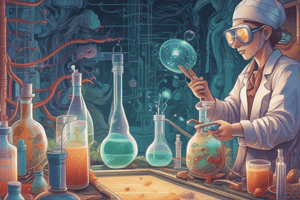Podcast
Questions and Answers
Explain the function of the objective lenses in a microscope and provide the magnification power for each type.
Explain the function of the objective lenses in a microscope and provide the magnification power for each type.
The objective lenses in a microscope are used to increase the size of the microorganism being viewed. The magnification power of the objective lenses are: Low objective lens (4X), Medium objective lens (10X), High objective lens (40X), and Oil objective lens (100X).
What is the purpose of the gas lamp (burner) in the laboratory?
What is the purpose of the gas lamp (burner) in the laboratory?
The gas lamp (burner) is used for the sterilization of inoculation loop.
What is the purpose of the condenser in a microscope?
What is the purpose of the condenser in a microscope?
The condenser in a microscope is used for the concentration of light.
Describe the function of an incubator and the conditions it provides for microbial growth.
Describe the function of an incubator and the conditions it provides for microbial growth.
Explain the process of measuring magnification power in a microscope and provide the magnification equation.
Explain the process of measuring magnification power in a microscope and provide the magnification equation.
What is the function of the condenser in a microscope?
What is the function of the condenser in a microscope?
What is the purpose of the gas lamp (burner) in the laboratory?
What is the purpose of the gas lamp (burner) in the laboratory?
How is the magnification power of a microscope measured?
How is the magnification power of a microscope measured?
What does an incubator provide for microbial growth?
What does an incubator provide for microbial growth?
What is the main function of a microscope's objective lenses?
What is the main function of a microscope's objective lenses?
Explain the function of the gas lamp (burner) in the laboratory and its role in microbiology procedures.
Explain the function of the gas lamp (burner) in the laboratory and its role in microbiology procedures.
Describe the parts of a microscope and their functions in microbiology lab procedures.
Describe the parts of a microscope and their functions in microbiology lab procedures.
What is the purpose of the incubator in a microbiology laboratory and what conditions does it provide for microbial growth?
What is the purpose of the incubator in a microbiology laboratory and what conditions does it provide for microbial growth?
Explain the concept of magnification power in a microscope and provide an example calculation.
Explain the concept of magnification power in a microscope and provide an example calculation.
What is the function of the condenser in a microscope and how does it contribute to the visualization of microorganisms?
What is the function of the condenser in a microscope and how does it contribute to the visualization of microorganisms?
Explain the difference between positive and negative staining techniques in microbiology.
Explain the difference between positive and negative staining techniques in microbiology.
What is the purpose of differential staining techniques in microbiology?
What is the purpose of differential staining techniques in microbiology?
List and briefly explain the types of simple stains used in microbiology.
List and briefly explain the types of simple stains used in microbiology.
How does the Gram stain technique classify bacteria?
How does the Gram stain technique classify bacteria?
What is the purpose of special stains, such as endospore and flagella stains, in microbiology?
What is the purpose of special stains, such as endospore and flagella stains, in microbiology?
Flashcards are hidden until you start studying




